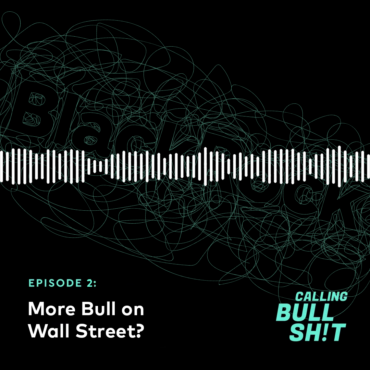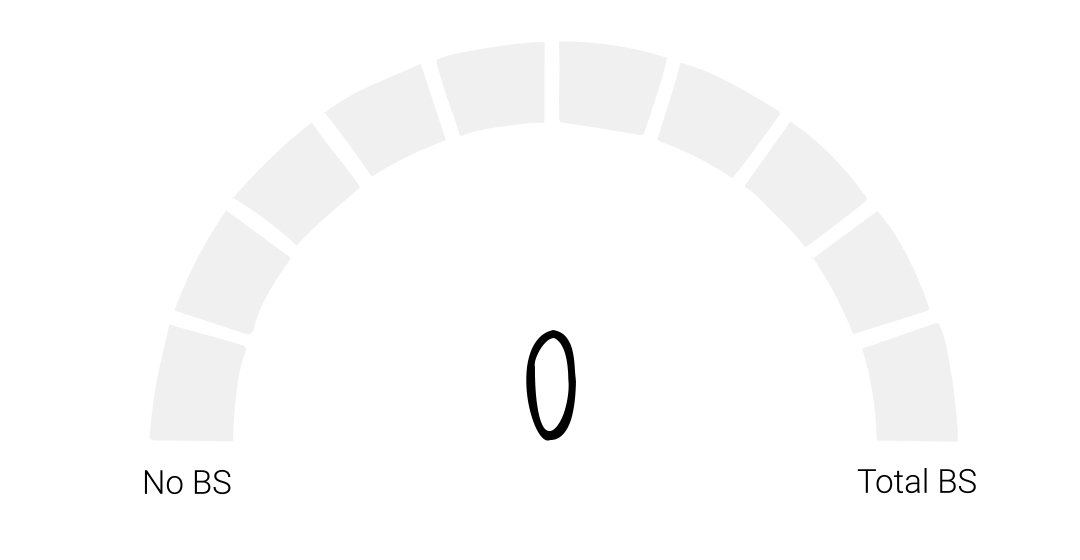
BlackRock: More Bull on Wall Street?
Is investment firm BlackRock really using their power for good? In this episode, we grab the bull by the horns to find out if BlackRock is truly pushing for change.
 play_arrow
play_arrow
Whistleblowers: A very special kind of bs detector Calling Bullsh!t
 play_arrow
play_arrow
McKinsey: Something to hide? Calling Bullsh!t
 play_arrow
play_arrow
Web3: A more humane, egalitarian, and decentralized internet? Calling Bullsh!t

 play_arrow
play_arrow
Juul: Blowing Smoke? Calling Bullsh!t

Reporter at Bloomberg News & Author of “The Devil’s Playbook: Big Tobacco, JUUL, and the Addiction of a New Generation”

Health Correspondent at TIME & Author of “Big Vape: The Incendiary Rise of Juul”

Stated purpose: Transition the world’s billion adult smokers away from combustible cigarettes, eliminate their use, and combat underage usage of our products.
“Hey bro, can I hit your vape?”
If you’re one of the 5 million Gen Z-ers who smoke e-cigarettes, the answer is a resounding “bet.” E-cigarette manufacturer JUUL set out on a mission to build a safer cigarette alternative, but along the way, a whole new generation became hooked on nicotine. Is Juul addicted to profits? Or was this simply a slip on their journey toward reducing harm?
I don’t think that Adam and James set out to addict 5 million teenagers on nicotine
– Lauren Etter

MUSIC: “Bonanza” by Majk Jutbo via Epidemic Sound
[SOT Tess (NYU vox pop)] I remember my best friend’s older sibling, like drove up in a car. We were like freshmen in high school and they were like, try it. This is like the new thing. Try it. And we were like, whoa, this is so cool!
[SOT Ravis (NYU vox pop)] you can puff it whenever. and then the nicotine so concentrated. You can hide it.
[SOT Reid (NYU vox pop)] You know, everyone has one, it’s very accessible and I think you just start doing it and can’t stop, I guess, is what I would say.
TY MONTAGUE (VO)
They’re talking about JUUL, the e-cigarette that took the nation by storm just a few years ago and has become ingrained in youth culture… …even spawning viral YouTube hits like this:
[SOT Where’s My JUUL?? Feat. Lil Mariko] Hey, have you guys seen my JUUL? I like, literally, just had it in my hands… like, you gave it back to me right? I let you hit my Juul and you gave it back to me? You didn’t take it, did you, you wouldn’t do that to me? Where’s my Juul? Where’s my Juul?[scream vocals] Where’s my Juul??! So not cool! Where’s my Juul??!
MUSIC: ‘In Passage” by Migration via Blue Dot Sessions
TY MONTAGUE (VO)
Welcome to Calling Bullshit, the podcast about purpose-washing…the gap between what companies say they stand for and what they actually do — and what they would need to change to practice what they preach.
I’m your host, Ty Montague and I’ve spent over a decade helping companies define what they stand for — their purpose — and helped them to use that purpose to drive transformation throughout their business.
Unfortunately, at a lot of organizations today, there’s still a pretty wide gap between word and deed. That gap has a name: we call it Bullshit.
But — and this is important — on this show we believe that Bullshit is a treatable disease. So when the bullshit detector lights up, we’re going to explore things that a company should do to fix it.
In this episode, we’re going to look at Juul. The company’s mission is “harm reduction” they want people to stop smoking cigarettes and start using JUUL, which is designed as a potentially life-saving alternative.
Here’s how co-founder Adam Bowen put it in a promotional video:
Adam Bowen: 50 years from now, nobody is going to be smoking cigarettes. They’re going to look back and think, oh my God, I can’t believe people used to do that. And now I think it’s actually going to happen much faster in large part because of the progress that we’ve made.
TY MONTAGUE (VO) It sounds revolutionary — but is it actually true?
MUSIC: “TROD ALONG” by BLUE DOT SESSIONS
TY MONTAGUE (VO) To tell JUUL’s story, we need to (let’s) start with a quick history of the industry Adam and James wanted to disrupt: Big Tobacco.
Tobacco use goes back thousands of years. It grows wild in the Americas, and has long been valued by indigenous peoples as a sacred and medicinal plant.
In 1492, Taíno people of the Caribbean gave Christopher Columbus some dried tobacco. Soon smoking became all the rage with Europe’s, who apparently just loved that buzz.
In the 1600s, English colonists set up large tobacco plantations in the Southeastern United States, which fueled the demand for enslaved labor. And by the late 1800s, big companies like Philip Morris (now Altria) and American Tobacco began to dominate the market.
Mass production made cigarettes popular. So did ads that portrayed smoking as a pleasurable, glamorous habit. Some of them even featured “doctors” — played by actors in white coats.
INSERT: More Doctors Smoke Camels ad: Time out for many men of medicine usually means just long enough to enjoy a cigarette. And because they know what a pleasure it is to smoke a mild, good-tasting cigarette, they are particular about the brand they choose… More doctors smoke Camels than any other cigarette.
TY MONTAGUE (VO) A lot of doctors did smoke back in the 40s, when this ad was made. But Big Tobacco specifically used this kind of messaging to counter growing concerns around health. By the mid 60s, though, the evidence was clear:
SOT:CBS Surgeon General Report: Tonight’s CBS report begins with this historic announcement by the Surgeon General of the United States on January 11th, 1964. It is the judgment of the committee that cigarette smoking contributes substantially to mortality from certain specific diseases and to the overall death rate.
MUSIC: “OUTWARD & DOWN” by ELLIOT HOLMES courtesy of Epidemic Sound
TY MONTAGUE (VO): Big Tobacco knew this. They’d also discovered that the key ingredient in their product, the thing that gave you that buzz, was nicotine. So they optimized for tobacco plants and cigarettes that delivered more of the drug into a smoker’s lungs.
And they knew it was addictive — tobacco executives admitted that at least as far back as the early 60s, according to internal company documents. But publicly, they claimed otherwise, hoping to steer clear of the FDA. After all, if your product is addictive AND it causes cancer, why should regulators allow you to sell it at all?
Finally, in 1994, the hammer fell.
SOT: CSPAN 1994 Sen. Henry Waxman): The Chief Executive Officers of our nation’s tobacco companies are testifying together before the United States Congress….The truth is that cigarettes are the single most dangerous consumer product ever sold.
TY MONTAGUE (VO): The Master Settlement Agreement that came out of these hearings put strict limits on the sale, advertising, packaging, and distribution of tobacco products. Some would say Big Tobacco got off easy, but for sure, the days of easy money in the tobacco industry were over.
Flash forward to 2005, when two young smokers, Adam Bowen and James Monsees, were grad students in Stanford’s prestigious product design program.
Lauren Etter: And they kind of hatched their idea and became friends over cigarette breaks outside of their classroom at Stanford University.
TY (VO): That’s Lauren Etter, an investigative reporter who’s covered the JUUL story in depth.
Lauren Etter: So when you’re at Stanford, you’re always looking for, what are the products and the areas that are ripe for innovation? And the cigarette was ripe for innovation. it’s not the nicotine that kills people, it’s the combustion. So they thought to themselves, if there was a way that we can just get people the nicotine that they want and that they’re addicted to, but in a safer way, we should be able to make a huge public health contribution by transitioning people away from the deadly dirty cigarette to a safer, cleaner nicotine.
TY MONTAGUE (VO): They could save millions of lives — and probably make some money doing it.
It turned out that solving this problem was a lot harder than it looked. But James and Adam hammered away at it for a decade, until 2015, when they finally launched their revolutionary product, JUUL.
JUUL delivered the “kick” smokers crave. But it was also everything a cigarette wasn’t: sleek, modern and easy to conceal. It produced no smoke, so it could be used surreptitiously, even indoors. And its pods came in a variety of tasty flavors, like Mango, Mint and Creme Brulee.
So Adam and James went off to work marketing JUUL to smokers, who tend to be older and less affluent. And they made it abundantly clear that young people and non-smokers should stay away, because nicotine in any form is highly addictive — and their goal was getting people to stop smoking.
Actually, that last part is completely made up. They didn’t do any of that. In fact, they did exactly the opposite. And the results are almost comically catastrophic. So get out your BS detectors, folks, and hang on tight. This one is quite a ride.
MUSIC:”Downhill Racer” by K4 courtesy of Blue Dot Sessions
JUUL says that its mission is harm reduction. So is that true, or is it just a bunch of bullshit?
TY MONTAGUE (VO): To learn more about where JUUL went wrong, I called up Lauren Etter, who you heard earlier. She’s a reporter at Bloomberg News and the author of “The Devil’s Playbook: Big Tobacco, JUUL, and the Addiction of a New Generation.”
Ty Montague: I guess I want to start out by asking, what was it that initially captured your attention? Why did you write this book?
Lauren Etter: So, I’m always looking for, interesting stories about companies that are making an impact on our lives in one way or another. And as the youth vaping epidemic was skyrocketing, where suddenly all these teenagers started showing up in the emergency room with, shortness of breath, what appeared to be burns on their lungs and then it looked like it was tied to vaping of some kind. I was fascinated that there was a very high flying Silicon valley startup in the middle of a public health crisis.
Ty Montague: Can you talk about their pitch to early investors? Like, how did they tell the story of what they were trying to do?
Lauren Etter: It was both an innovation pitch and a public health pitch. On the innovation side, it was, here’s this product that 1 billion people use in the world, 34 million Americans smoke cigarettes. So, the cigarette is literally the same, essentially, as it was a century earlier. It’s essentially paper with shredded tobacco leaf, you know, rolled up inside of the paper, you light it on fire—
Ty Montague:[laughing]
Lauren Etter: And you inhale the smoke. So if there isn’t a product that’s ripe for innovation, I don’t know what is, so it’s a cigarette.
Ty Montague: [laughing] Right.
Lauren Etter: The public health pitch was really interesting. So they thought to themselves, why are so many people still smoking and why is it still killing them, and how can this be happening? There’s got to be a better way to get people what they really want in a cigarette, which is the nicotine. They sold that story and they sold it very well.
Ty Montague: Yeah. And it seems to me that the mission that this company had from the very beginning is fundamentally a good one. Essentially harm reduction, right? How serious do you think they really were about that mission?
Lauren Etter: I think that they were very serious about that mission. I think they truly believed that they could have a public health impact, but they also realized that there was a huge market to be tapped. And we’ll get to what eventually happened, but I think those balances got a little bit out of whack.
Ty Montague: So, what was the kind of key technical challenge that they had to solve in order to actually achieve this mission, to create a safer alternative to smoking?
Lauren Etter: One of the first challenges was very rudimentary, How do we heat up the tobacco? So the first iteration of the product was essentially a little tube that heated up tobacco pods. So, it was a very poorly designed device. it was almost like a lighter. You kind of snap it and it would kick on the butane heater that would heat the tobacco. It was shocking people. It was literally shocking people on the lips—
Ty Montague:[laughing] Not what you look for in a, in a relaxing smoke,
Lauren Etter: Right! You just get a little jolt. They were presenting it to potential investors. And there’s a couple of scenes in my book where they go to pretty high level people presenting this thing and it like zaps them on the lips. And it’s super embarrassing for Adam and James to pride themselves on design, they went to the D school. This is the preeminent design school in the world. They eventually included a battery. But the challenge with just heating tobacco was that it didn’t satisfy smokers in the way that cigarettes did.
Ty Montague: So yeah, if you’re not getting the nicotine, there’s no way you’re going to get somebody to quit smoking.
Lauren Etter: I mean, it’s all about the nicotine. It’s only about the nicotine.
TY MONTAGUE (VO): It’s all about the nicotine – And let’s be clear – highly efficient doses of nicotine is (are) not a health treatment. According to the CDC – Using nicotine in adolescence can harm the parts of the brain that control attention, learning, mood, and impulse control. However, e-cigarettes did have the potential to create a far safer alternative to cigarettes. And the tobacco companies knew this. In fact, because they knew their cigarettes were killing people and they’re backs were against the wall, tobacco companies spent decades and billions of dollars on developing “safer” products which included vaporizing technology.
Lauren Etter: This was a huge moment for Adam and James. They realized that there was an archive containing millions of documents that the tobacco industry had made public, as a term of their settlement with the attorneys general and with the department of justice. So they got a lot of their ideas for innovation from these tobacco documents.They realized that they could use chemistry to create a nicotine solution that was as satisfying as a cigarette.
Ty Montague: Okay so these two young kids from Stanford finally build a little machine that looked like a thumb drive that heated nicotine salts or heated nicotine in a way that, that it could deliver as much or more of a, of a hit than a cigarette. I mean, this is a pretty amazing breakthrough, isn’t it?
Lauren Etter: It was a huge breakthrough.
TY MONTAGUE (VO): Adam and James now have Juul all teed up and are ready to go save lives by convincing smokers who are primarily older to switch from smoking cigarettes to using a Juul. But their first hire was Kurt Sonderegger – a marketing guru from Red Bull. A company that clearly targets young people.
Lauren Etter: I really think that they found Kurt because he was kind of in the area and at the time it wasn’t easy to attract people to come work for a tobacco startup. I think that they just needed somebody who understood marketing, which he did. And I think that they did have this kind of initial idea of like, how can we frame it as a product that will be interesting to people. And that might have a little bit of cool factor. And of course being a Silicon Valley company, that’s a key part of the equation.
Ty Montague:So Kurt Sonderegger left the company pretty early and the founders on their own went out and hired their first outside marketing partner, a company called the Cult Collective run by Chris Kneeland. And it seemed like they really seemed to understand this premise, that Juul was on a mission to be a harm reduction company. You know, I’m a former ad guy myself. And so, you know, I was looking at it with my ad guy eyes and the idea for the first campaign that they showed to James and Adam seemed like at least the right strategy to me. Basically it went directly against cigarettes, comparing cigarettes to old anachronistic technologies—boom boxes and Atari joysticks— and positioned Juul as the modern alternative. And the tagline was the evoluution of smoking with the double uu like Juul. But basically it went directly at smoking and knocked it as old-fashioned. Why didn’t James and Adam buy that direction?
Lauren Etter:I don’t think Adam and James looked at what Chris Kneeland did and said, this is not the direction we want to go. The board of the company at the time was really saying, we should probably bring in our own marketing person. They brought in a new team—
Ty Montague: This new person, Richard Mumby right? Richard Mumby joined as the CMO midstream. And he had his own ideas about what direction the marketing should go.
Lauren Etter: So, it was evident almost immediately when Richard Mumby came in and he had an art director he brought with him, a guy named Stephen Bailey, They initially just thought that Chris’s vision was missing the boat. it wasn’t elevating the product enough.
Ty Montague: It also wasn’t very cool. Right. the message I keep getting is these guys, somebody, somewhere, whether it was James and Adam or the board, somebody wanted this company to be cool.
Lauren Etter: I think Richard Mumby was really driving a lot of that.
Ty Montague: So Stephen Bailey, who is mostly from the world of fashion, did campaigns for Gap and Hypebeast and Bonobos, he comes up with a campaign that became known as Vaporized. Which is sort of inspired by his buddy Terry Richardson’s look, that kind of gritty, sexy models, juuling. And it’s, you know, sophisticated and cool and just perfectly out of reach of, you know, teenagers who of course will want it. And you know, the Vaporized campaign, when I look at it today, I look at it and go, these are exactly the same marketing techniques that had been used by big tobacco for years, this sexy lifestyle imagery, no?
Lauren Etter: Absolutely. Certainly Adam and James were aware of these marketing kind of strategies and the problems related to them. I don’t actually believe that Richard Mumby and Stephen Bailey sat down, looked at the tobacco archives and said, how can we recreate this tobacco industry playbook? I really don’t.
Ty Montague: Right.
Lauren Etter: I don’t know how knowledgeable Richard and Stephen were really of the tobacco stuff. I mean, it was all happening very, very fast. They like did the photo shoot and the campaign, the mock-up in a very short period of time. So I really believe that the Vaporized campaign was the best work product that Stephen and Richard could come up with. It wasn’t necessarily a nefarious way to get people, young people, hooked. It was a way to make their product cool.
Ty Montague: I agree. And I just, I think the whole notion of trying to make the product cool is where they fell down.
Lauren Etter: Yes, it was their undoing a hundred percent. like that was their original sin, was the marketing campaign. And not treating this highly addictive drug with enough care, which they should have done.
Ty Montague: They do a big launch party at JAC Studios, a super cool place in New York. 400 young people, models and photographers and young fashionistas and punky looking skateboarders. They hire a bunch of young influencers to push the event and Juul on social media. And, spoiler alert, it works!
Lauren Etter: Their brand got out there in a very important way where I think people definitely started seeing it as almost this, what is this thing? Nothing on their advertising said it was addictive, nothing on their advertising said that it contained nicotine. It was just this cool flashy device that, you know, you could have as a fashion accessory.
Ty Montague: Right.
Lauren Etter: So eventually teens started becoming interested. Gas stations start running out of it. People start posting on Twitter desperately. When are you gonna restock Juul?
Ty Montague: Right. So they can’t make them fast enough and they’re having scaling problems and then, you know, cue, scary music, parents start to wake up to this growing issue with their kids and they start to freak out. What were the first signs of that? Like, the first sign of like, uh oh Houston we may have a problem?
Lauren Etter: Pretty early on. principals were finding Juul and like, not even knowing what it was. Parents were finding it in backpacks and bedrooms and stuff like that. And so there’s this kind of like percolating, kind of controversy and the tobacco control group, they really started sounding alarm bells. They started, you know, calling on Congress to regulate this industry because a key part of this story is that at the time that Juul launched there was no regulation on the sale of electronic cigarettes.
TY MONTAGUE (VO): Regulation – or the lack thereof – is a key point. In 1998 52 state and territory attorneys general signed the Master Settlement Agreement (MSA) with the four largest tobacco companies to settle dozens of state lawsuits and to reduce smoking, especially in youth.
From there on out tobacco companies had legal marketing obligations. No more obscuring the health risks, No more billboards, sponsoring team sporting events, cartoons of any kind, and on and on. The Master Settlement Agreement turned out to be incredibly effective in reducing teenage smoking.
But, when e-cigarettes and vaping came on to the market they were not covered under that agreement. So they were allowed to advertise however they wanted – including homework sites for middle schoolers and even on Nickelodeon.
Lauren Etter: Yeah. So they did advertise on these places and, they explain it by saying that they used a third-party marketer and they didn’t have control over that, but they did. And they actually, sent Juul representatives into schools to teach about addiction and how you shouldn’t use nicotine. It was this crazy, weird, reverse psychology that the tobacco industry had used for years. you know, don’t smoke. It’s not cool. But then it turns out that their marketing, was actually attractive to youth, you know?
Ty Montague: Yeah. And at the same time, those people went into schools and said, well, you shouldn’t use it, but it’s perfectly safe.
Lauren Etter: Right. It was a really bad look and it was not good.
TY MONTAGUE (VO): Meanwhile, Altria, the tobacco giant formerly known as Philip Morris, had been trying to buy a stake in JUUL… and as the company came increasingly under fire, that offer started to look more attractive.
Lauren Etter: Altria makes Marlboro cigarettes, the number one selling cigarette in America. And inside Juul.. They saw it as a way to, from the inside, take their harm reduction plan and really use Altria to give them a huge sales advantage and access to customers. So the deal was done in December 2018 and it was the worst timing ever. There’s new regulations on the industry. The e-cigarette industry, at least the pod makers, had to take off all of their flavored products. I mean, Juul kind of did this voluntarily in anticipation of the FDA going in this direction. The FDA is now deciding whether or not Juul will continue to be sold, whether or not it will be legal for Juul to continue selling its product.
Ty Montague: When do we hear about that?
Lauren Etter: toward the end of the year. So this is really, literally Juul is hanging by a thread. and the FDA’s holding the thread. They either will get the go ahead to continue selling their product or they won’t.
Ty Montague: This story made me a little sad, I have to say. Because it seemed like this is a company that was born with a great quest to take down big tobacco and save the world from cigarettes. They had the breakthrough product to do it. They just spiked the ball on like the five yard line and marketed it to the wrong people, to teenagers. Is that too kind or too mean? Like, is that fair?
Lauren Etter: Well, I feel the same way. I mean, I don’t think that Adam and James set out to addict 5 million teenagers on nicotine.
Ty Montague: Right. Unintentional.
Lauren Etter: But you really do as businesses and particularly in Silicon Valley, I believe you have a responsibility for how your product is marketed and sold.
Ty Montague: So Lauren, I have a question that I ask all of our guests. So I will ask it of you. Are Juul just a bunch of bullshitters?
Lauren Etter: I dunno. Is there like a scale or something?
Ty Montague: Yes, yes. That’s where I was going. we have a thing called the bullshit scale. So on a scale of zero to 100, zero being zero bullshit, the company means everything that it says and 100 being just complete BS, where would you rate Juul?
Lauren Etter: Well, I think that you can’t discount their past and like I said at their original sin, so I think that that gives them a lot of points on the bullshit meter, honestly. So that puts them to 50. I think that they’re trying. I think that they do have a valid harm reduction mission. But again, the youth threat just lingers out there. So I would say that between zero and a hundred, I would put them at about a 60.
Ty Montague: Yeah. That’s fair. And by the way, that can move, What is the one thing that you think Juul should have done or still should do to solve their problem?
Lauren Etter: Well, I think that they should have treated their product more carefully. They should have treated it less as a fashion accessory and more as a pharmaceutical grade product that is designed to help people quit smoking. They should have been more boring, but listen, we all acknowledge and know and realize that in no world in Silicon Valley would a boring company achieve a $38 billion valuation. There’s fundamental flaws in the way that Silicon Valley is structured.
MUSIC: BS THEME REMIX
Ty Montague: That’s right.
Lauren Etter: And I think that that’s also a big part of the problem.
Ty Montague:Yeah. Very interesting. I completely agree with that. Alright. Thank you very much for joining us today, Lauren.
Lauren Etter: Thanks for having me, fun to talk to you.
TY MONTAGUE (VO): So is JUUL really “transitioning the world’s billion adult smokers away from combustible cigarettes, eliminating their use, and combating underage usage of their products,”? Based on what I’ve heard so far, I’m calling bullshit.
But after the break we’ll hear some concrete ideas to get JUUL back on track from two more experts on (in) the vaping industry.
———————————-
AD BREAK
———————————-
MUSIC: “IN Passage Remix”
TY MONTAGUE (VO): Welcome back. In Calling Bullshit, we’re not just cursing the darkness, we want to light some candles too, so I’ve asked two vaping industry experts to propose some concrete things that JUUL and the current CEO, KC Crossthwaite could change to actually do their story of harm reduction.
Ty Montague: First I’d like to welcome Jamie Ducharme, author and journalist.
Jamie Ducharme: Thanks so much for having me. So I am a health correspondent at Time magazine And my first book is called Big Vape: The Incendiary Rise of Juul and it tracks, Juul from its very origins up until more or less the present day, going into many of the decisions they’ve made over time and how they got into the hot water that they find themselves in now.
Ty Montague: It’s a great book. I enjoyed it a lot. We’re also joined by Greg Conley. Greg, thank you for being here today. Can you tell us a little bit about your background?
Greg Conley:I run a nonprofit called the American Vaping Association. It’s a 501c4, it advocates for pro vaping policies with the end goal of maximizing the number of smokers who use these products to quit smoking and improve their health. Back in law school at Rutgers University in Camden, New Jersey, I was a dedicated smoker and in 2010 I saw these things called e-cigarettes, I quit with them and I found that there were activists out trying to ban these products while leaving combustible cigarettes entirely untouched. That didn’t sit right with me. So I spent about three years as a volunteer consumer advocate with the US’s largest consumer association for users of smoke-free nicotine products. And the AVA has been going for around eight years and we’ve been fortunate enough to do a lot of media, get some attention to this issue and work with a lot of great public health people who have come around on this issue as well.
Ty Montague: Thank you, Greg. So let’s get into ideas for positive actions that Juul could take. Jamie, in two minutes or less, what is the number one thing that Juul should do to solve the mess that they are currently in?
Jamie Ducharme: Basically what it boils down to for me is that Juul should just do less. And what I mean by that is throughout the company’s history, it has made so many unforced errors that have made it really difficult to support the company. I think the flashy marketing campaign that they came out with is one great example. I mean, they didn’t have to partner with Instagram influencers and buy a Times Square billboard, but they chose to, because at that time they were kind of operating as a trendy startup more than they were as a company that straddles the line between tobacco and public health. They didn’t have to go into schools and pitch schools on an anti vaping curriculum that they developed, but they did that. They didn’t have to just recently buy out an entire issue of a research journal to promote their own research. So really what I’m getting at is that the problem for Juul has always been less about its product, which actually is a good product that works well and can be effective for adults. So in my opinion, if they just stripped away kind of all of their external activity, paid less attention to marketing and trying to be a thought leader, an innovative company, and just sold their product and did the research that they need to do and, listened to what the FDA was asking of them— I think they would be in a far better position than they are today.
Ty Montague: Yeah, no, that, that makes a ton of sense, it’s like put the shovel down, just stop digging. Thank you, Jamie. Greg, your turn. In two minutes or less, what’s your idea to get Juul back on track?
Greg Conley: There are two different ideas popping around my head. First is rather simple. There is a process at the FDA, beyond the pre-market tobacco application known as the MRTP process. Yes, there are a lot of acronyms in this field. MRTP stands for modified risk tobacco product. And there are at least two products, General Snus, which is a teabag shaped thing of tobacco that goes in your upper lip, as well as a Phillip Morris product called IQOS that heats tobacco and does not burn it. They have gotten approval through that MRTP process at the FDA. It allows them to make health based claims in marketing. And I think with so many people in America, the vast majority inaccurately believing vaping could be just as deadly as smoking going through that MRTP process, I think, is going to be essential to regaining public trust and actually correcting misperceptions, not only among the general public, but among doctors, among regulators, among state legislators.
And the second is there are still tremendous amounts of knockoffs of Juul and products that are heavily inspired by Juul that may not infringe on their patents, but nonetheless are either on the market illegally or on the market through the grey market, where it’s not technically illegal, but it is something that the government could take action on. Juul being more aggressive, going to more governments and saying, ‘look, we did the right thing, we went through the process, we are regulated by the FDA, these people aren’t, and we need your help’. That could in some way bring about more legitimacy. But, really, this is a multi-year fight for Juul to regain any, whereas as Lauren puts it in her book, permission to exist. It’s a long fight for them ahead.
Ty Montague: So, in a way you’re advocating for them to become an activist in the space, advocating for saner regulation and maybe fewer cowboy companies?
Greg Conley: Not so much with being an advocate for better regulation, but more pointing out that they make products that are tightly regulated by the FDA, presumably they will have authorization from the FDA. And meanwhile, yes, there are these cowboy companies out there.. And I think they can be even more aggressive on that point without risking any reputational damage, except for people like me, who just wants adults to be able to vape.
Ty Montague:Yeah, that makes also a ton of sense. Thank you, Greg. Okay. My turn now, I think Juul is in a pretty deep ditch and so I think it’s going to take some fairly radical action to get them out of it, but I think that this could actually work. As you pointed out, Greg, they sold out to Big Tobacco by taking a huge investment from Altria. And so I think the hatred and mistrust that it created really destroyed the brand. I think they need to rethink their whole model. I think Juul should be a medical device. I think they should go to the pharmaceutical industry instead of the tobacco industry. Go to Pfizer or GSK who both have smoking cessation products in the market and see if they can get those companies interested in the underlying technology. These are both companies with really deep pockets and the patience to guide a new medical technology through the regulatory process. They also both have the necessary army of salespeople who know how to sell a new medical technology through to doctors. And, so it becomes a prescription medical device that doctors can prescribe to their patients who smoke as a way to reduce harm. And that market is still massive. And with some grownups at the wheel, the former Juul could finally live up to its true and very positive promise. Any thoughts on that? Is that crazy talk?
Jamie Ducharme: I don’t think it’s crazy talk. I do think the huge benefit of what you’ve just described is that it would solve a lot of Juul’s use issues. I think the drawback, which I’m sure Greg would point out if I didn’t so I’m getting ahead of it, is that if you make something a prescription product you’re guaranteeing that fewer people will have access to it or will choose to seek out access to it. So I think it’s a two-sided coin where yes, you’ll prevent a lot of teenagers from using it, which is great, but you’ll also kind of lose out on some of the adults who might use it.
Greg Conley: Yes. And as Jamie noted, we live in a country where about 25% of Americans do not have a primary care doctor and with cigarette smokers being of lower socioeconomic status on, on average, you’re probably more looking at 35%, 40% of smokers without a primary care doctor. The prescription model is problematic for a number of reasons. Pfizer and GSK both place great value in their relationships with the tobacco control community, with the people who are trying to ban Juul. And the problem is, is that campaign for tobacco free kids, the American Lung Association, American Heart Association, if there’s any hint of Pfizer or GSK partnering with an Altria owned company, a cigarette company, they won’t stand for it. There’s a recognition at the FDA that long-term usage of smoke-free nicotine can be a public health benefit, but under the pharma route, there really is no way to get a product approved for long-term nicotine replacement. Smoking cessation is kind of a misnomer. It’s really about nicotine cessation at the FDA center for drug evaluation, and research. So there’s a lot of problems with that route. Certainly Juul may one day decide we need to do this, especially if FDA denies them. I just don’t think it will be with Pfizer or GSK for reputational reasons.
Ty Montague: Well, that makes sense. you know way more about this, not surprisingly, and uh if they’re the wrong partners then so be it. But just to pursue this for a sec—one of the things that I think got Juul in trouble was this hurry up offense, like they were in a hurry to get big fast, deliver a value for their shareholders. And I think some patience is needed and I completely agree that it would reduce dramatically the sales in the short-term to go to a prescription model. And what I’m arguing is that’s a good thing, that will give them time to have a business of some kind for a period of time while trust is healed because trust has been broken. So, following that thread, I want to go back to a couple of your ideas. I mean, Jamie, the idea of doing less I think is very interesting. You know, I’m reminded of the story of J and J, I don’t know if either of, you know, this story because it was quite a while ago, it was back in the early 1980s, but there was a psycho who started poisoning Tylenol in the Chicago area, three people died— and J and J’s response was to pull all of the Tylenol bottles off every shelf in America. And they did that because they understood that their entire reputation as a business was on the line and that if they didn’t immediately swallow that very bitter pill, no pun intended, they would be deemed to be part of the problem in the court of public opinion. And, it’s actions like that, that build trust for people. Do you think there’s a world in which Juul would take more dramatic action, Jamie in keeping their product out of the hands of young people?
Jamie Ducharme: Yeah. I mean, I actually do think it was fairly dramatic for them to take all of their flavored products off the market. As I said before, that was a huge part of their revenue stream. So I think that was a dramatic action. But my perception of this company is just that they sort of can’t help themselves, like at several junctures when I was reporting my book, it seemed like they were on the right track or they’d gotten the right advice from health experts. They had all of the tools to make good decisions and then they just veered left and did the complete opposite thing. So in my view, it’s maybe at this point, less about making further dramatic actions and more just about doing the things that people have told them for years will work. I mean, they already have market share. They already have name recognition. In my eyes there’s not a whole lot they have to do except stop getting in your own way.
Ty Montague: Yeah, no, that’s, that’s very interesting. I agree. Greg, your idea about Juul essentially pivoting to pin a star to their own chest and become the sheriff in the space. I think the idea of pivoting to be a more activist brand that is pro vaping, but anti-smoking, and anti cowboy companies would be another way to potentially heal trust. Do you think that that’s something that they would have the stomach to do?
Greg Conley: Absolutely. They have a very large team of attorneys. They have a lot of influence from Altria, which has never shied away from being in the courtroom and going after their competitors with a great deal of fury. So I think that is a potential pathway.
Ty Montague:Yeah. is the Altria ownership stake a conflict of interest there? Would they ever say, ‘No, we want to buy ourselves back. We’re going to, we’re going to go find a big rich friend and somebody who is not a tobacco company and we’re going to buy your stake?
Greg Conley: So I’m sure Altria would be thrilled to be rid of the albatross that has become Juul. But ultimately I think Altria wants to stick around. I think they see value in the brand, but you never know. Silicon Valley is a place, as Altria learned, where you have crazy valuations and people can sometimes bring out the checkbook in unexpected ways.
Jamie Ducharme: The Altria investment brought so much bad press and just further scrutiny on Juul. But at this point they have so many lawsuits coming at them that I think they sort of need Altria’s support at this point. The FTC is actually trying to unwind or suing to unwind that investment. So potentially this will be out of their control and will happen whether they like it or not. But I think at this point, Juul is a little vulnerable and kind of needs that.
Greg Conley: Jamie brings up a very good point with the lawsuits against Juul, because what you likely end up with is, you now have multi-district litigation. There’s already been a settlement in North Carolina, and there’s likely to be a very large substantial settlement with all of the state’s, school districts, local governments that have sued Juul. And so I think Juul recognizes that part of their pathway forward is to enter into a multi-district settlement that restricts them in ways that they are already restricting themselves. So I think part of Juul’s strategy is eventually we’re going to have to settle, we’re going to have to cut a big check and Altria is going to be helpful with that legal strategy but they see that settlement as their path to permission to exist in the future.
Ty Montague: It strikes me that, you know, there is more that the company could do to keep its products out of the hands of young people that would have potentially symbolic value. One is biometric locks. And, you know, although the gun industry has its own issues, and has been slow to actually implement ideas like this, there are biometric locks that make it impossible for anyone to fire a gun if they’re not the owner of that gun. That might be possible in a Juul device as well. Um, what do you think about doing something like that?
Greg Conley: There’s great potential in that idea and Juul has already explored it. When they entered the market in Canada, they attempted to do a system where people would have to log in and upload a copy of their driver’s license simply for their product to be able to work. Then they ran into the problem that the app stores for both Apple and Google, Android, et cetera, they have banned all vaping product apps. But, you need to keep in mind with these tech options, the places with the highest smoking rates in America, West Virginia, Mississippi, Louisiana, Alabama. These are states that do not have in some places consistent internet connection. These are places where some people live without the internet, without a phone with 4g enabled from their home. So you can’t forget about the lower socioeconomic smokers who if you make it too techie, they may not be able, they may just decide, you know, what’s really easy? Lighting up a Marlboro.
Ty Montague: Right. what about treating it like cannabis and making dispensaries? In other words, just making it harder to get at?
Jamie Ducharme: I do think you’d run into some of the same access problems we were talking about with the prescription products, but, you know, at the same time, this is the huge issue for both and the vaping industry as a whole. So I do think to your earlier point, dramatic action, might be in the long run, a better path for them. it’s an interesting idea. And maybe something they should think a little more seriously about sort of a short-term drop in profits in pursuit of fixing this long standing problem.
Greg Conley: Yeah. Again, restricting Juul to age 21 plus stores in a major American city, Philadelphia, New York city, et cetera. That’s one thing, because you don’t have to travel far to get to one of those age restricted tobacco stores. But if you’re a smoker in the middle of Kentucky, you may, it may take you three minutes to get to a 7/11 that sells cigarettes and Juul, but you may have to go 25 minutes to get to a tobacco shop. So there are problems with that model. I would prefer if you’re going to do it, you do it legislatively where not just vaping products, but cigarettes as well get restricted to age restricted stores. And there is some form of geographic limitations, where if a population is not X, then there are less restrictions because we want people, it’s not like cannabis where you go to a store once every two weeks to get what you need. People are used to going in and buying their pack of cigarettes in the morning, every day or every other day.
Ty Montague: Okay. is there anything else that you think Juul ought to consider doing in order to get themselves out of this ditch?
Jamie Ducharme: One idea I’ve heard. I’ll just throw it out there cause it’s something I’ve heard that I find interesting— Is the idea of actually redesigning what the Juul device looks like. Because a lot of the criticism the company gets is that the product is so tech-y and looks like a flash drive and it’s easy to conceal and to use discreetly like, you know, in a classroom or in a home, you wouldn’t necessarily know that someone’s using it. So I have heard it said that potentially if Juul wanted to really take a dramatic action, which would set off a whole separate process of, you know, needing to file new FDA applications they could think about making the device look less appealing.
Ty Montague: Yeah. I like that. I think that is interesting. Greg, anything else?
Greg Conley: I don’t think that is a bad idea at all. Ultimately to go back to Jamie’s earlier point, I think Juul just needs time not being, or not volunteering themselves, to be the center of attention. Adult smokers know they exist. The vapers that are using the product know they exist. And I think the farther you get away from the controversies of 2018 and 2019, when the company was being run by tech bros in Silicon Valley who actively resisted hiring people from the tobacco industry that knew what this fight was about and how dirty it could get, the better for Juul. So I think we need, as Jamie said, less big ideas and more just functioning as a company and seeing their youth usage rates drop even lower than they are now.
Ty Montague: That’s great. So I want to thank you both for being here today. This was a great discussion. To wrap it up, I want to ask each of you to give Juul a BS score. So on a scale of zero to 100, 100 being the worst, total BS, and zero being the best, zero BS, what score would you give Juul? Jamie, you first?
Jamie Ducharme: So I think my answer to this question very much depends on time. I think for many of Juul’s early years, the score would be up pretty close to the top of the scale. I think now they have made some steps in the right direction. They have, you know, they’ve basically stopped advertising. They’re behaving more like how you would expect a company in this space to behave. So this is a long way of saying, now I would put the score maybe closer to 50. I think there’s definitely room for improvement, but they have also made some positive movements.
Ty Montague: Fair enough. I accept that. And Greg, what do you think about this? What’s your score?
Greg Conley: So similar to Jamie in 2017, 2018, early 2019, it’s more of a 50, perhaps? Ultimately when you look at the scope of bad behavior by American corporations, spilling oil in the ocean, killing people with bad drugs, et cetera, Juul never did any of that. Juul has never killed anyone. Juul has really never done physical injury to anyone. They had a bunch of very tech minded people that did not think they were in the tobacco industry, that thought everything was going to be okay, that they could outgrow their problems and they failed. So during that time period, maybe about a 50 today, I would put it more as a 20 because they are being more run like a tobacco company. Their CEO is a former Altria executive. They know how to stay out of trouble, which is one important thing for Juul to rebuild trust.
Ty Montague: Okay. Fair enough. Thank you for that. I appreciate you both being here.
Jamie Ducharme: Sure. Thanks so much for having me.
Greg Conley: And thanks for having me.
MUSIC: “In Passage” by Migration via Blue Dot Sessions
TY MONTAGUE (VO): OK, it’s time to give JUUL my official BS score. As you’ve heard from our guests today, this one is complicated. JUUL was definitely a huge bullshitter in the early days because they screwed up their marketing big time and wound up appealing to young people. But since then, they have made some important moves in the right direction. So I’m going to give today’s JUUL a 49. To weigh in with your own score visit our website, callingbullshitpodcast.com. We’ll track JUUL’s behavior over time to see if they can bring that score down. You’ll also be able to see where JUUL ranks on Bullshit compared to the other companies we feature on this show.
And if you’re running a purpose-led business, or you are thinking of beginning the journey of transformation to become one, here are three things you should take away from this episode:
1) Your purpose, once you’ve defined it, should be used to determine all of the actions that you take as a business, including your marketing. JUUL forgot this and paid a steep price for making a product that should have targeted adults and then marketing it to kids.
2) Once you have gotten off track, all is definitely not lost. You just have to get your actions back in line with your stated purpose. In JUUL’s case we’ve heard suggested actions like changing the physical design of the product to be less appealing to young people. And becoming an activist in the vaping space to try to get the whole category re-aligned toward adults. Your actions would be different, but the key is finding things to do that are “iconic” i.e. dramatic actions that re-build the trust that has been broken.
And 3) There’s a huge difference between managing shareholders and managing stakeholders. If your shareholders are happy, but your broader stakeholders aren’t, you’re going to need to make a change in your approach. In JUUL’s case, parents and the FDA were major stakeholders that JUUL did a poor job on managing, and it hurt them badly.
KC Crossthwaite, CEO of JUUL, if you ever want to come on the show to discuss these ideas or any other aspects of this episode, you have an open invitation.
///
MUSIC: “Bonanza” by Majk Jutbo via Epidemic Sound
TY MONTAGUE (VO) Thank you for joining us today, Lauren Etter, Jamie Ducharme and Greg Connely. You can find their social media handles on our site — callingbullshitpodcast.com. While you’re there check out Lauren’s book, The Devil’s Playbook, Big Tobacco and the Addiction of a New Generation, and Jamie’s book, Big Vape, The Incendiary Rise of JUUL.
Have an idea for a company or organization that we should consider for the show? You can submit it on the site too. That’s callingbullshitpodcast.com
If you got hooked on this show today, subscribe to the Calling Bullshit podcast on the iHeart Radio app, Apple Podcasts, or wherever you get your podcasts. You can follow us on Twitter at @callingbullshitpod.
Thanks to our production team: Susie Armitage, Amanda Ginzburg, D.S. Moss, Andy Kim, Hannah Beal, Mikaela Reid, Lena Bech Sillesen, Jess Fenton, and Basil Soper. Calling Bullshit was created by co:collective and is hosted by me,Ty Montague. Thanks for listening.
Tagged as: blackrock.

Calling Bullsh!t February 9, 2022
Is investment firm BlackRock really using their power for good? In this episode, we grab the bull by the horns to find out if BlackRock is truly pushing for change.
Agree or disagree with our Bullshit Score? Give us your take.